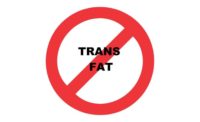Trans America
Labels are both friend and foe. Sure, they’re sources of information, but they’re also sore spots for shoppers who often are so misinformed and uneducated in this area that they can’t understand and interpret the Nutrition Facts panels they’re reading.
Calories, fat, cholesterol, sodium, carbohydrates, protein … How much is too much of which one, and why?
The Food and Drug Administration now tells us that trans fat is the ultimate evil when it comes not just to packaged products but fast foods. It comes as no surprise that shortenings that solidify at room temperature might solidify in your arteries, too. The question is, why did it take us so long to recognize this fact? (Extended shelf-life aside, perhaps it’s because partially hydrogenated plant oils just taste so darn good.)
When the FDA ordered food manufacturers to start listing the number of trans fat grams in their products back in January of 2006, panic set in. Rather than reveal to consumers how much of the scary stuff actually was in the cookies, cakes, doughnuts, pies, breads and crackers they’d been eating since tropical oils were replaced in the 1980s, companies immediately began reformulating their offerings, eliminating trans fat from everything, including the once tasty Oreo. (As I’ve said before, it will never again be the same.)
Kraft Foods, Inc., Northfield, Ill., removed the trans fat shortly after a nonprofit organization in California called BanTransFats.com, Inc., filed suit against the industry giant. The group’s goal? “The reduction and elimination of partially hydrogenated oils from all food products.”
And it’s succeeding.
According to the FDA, back in 2003, major food sources of trans fat were cakes, cookies, crackers, pies and bread (40%), and — to a lesser degree — potato chips, corn chips and popcorn (5%).
Today, take a stroll down the aisles of your local store, and the new labels on many of these products — “Trans Fat-Free! 0 Grams Trans Fat! No Trans Fatty Acids!” — literally jump out at you.
But concerns over trans fat go beyond the supermarket.
Not long ago, Chicago’s notorious Mayor Richard M. Daley suggested that restaurants be forbidden from cooking foods in trans fat.
This spring, Chi-town’s city council also instituted a ban on foie gras — goose and duck liver — that area chefs continue to battle. Most recently, Rick Bayless, head chef and owner of Frontera Grill (winner of the James Beard Foundation’s 2007 Outstanding Restaurant of the Year award) urged the mayor to repeal the decision in an effort to maintain the Windy City’s reputation for fine dining.
But I digress.
Feeling the heat from both consumers and government agencies, fast food purveyors nationwide — from Kentucky Fried Chicken to Burger King — are taking out the trans fat. (See “Slippery Slope,” page 48.) Currently, Massachusetts is considering a state-wide ban. Montgomery County, Md., and Philadelphia already have blacklisted the fat. On July 1, New York City began prohibiting its restaurants from cooking with it, too.
Geez, these days you can’t kill yourself by smoking cigarettes or eating trans fatty foods in public places. And I thought this was a free country.
But, wait! Consumers still can bake cookies from scratch using Criso.
Nevermind. Crisco shortening products have been “reformulated to contain zero grams trans fat per serving.”
Oh, well … Since this fast food nation embraced the latest trend, it’s become a trans fat-free America. Now, if food producers could just find a way to eliminate those pesky saturates.
Fat chance.


